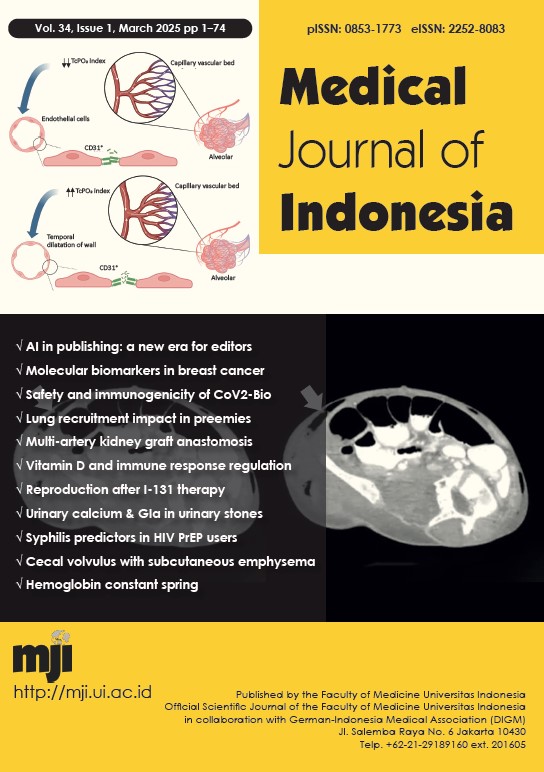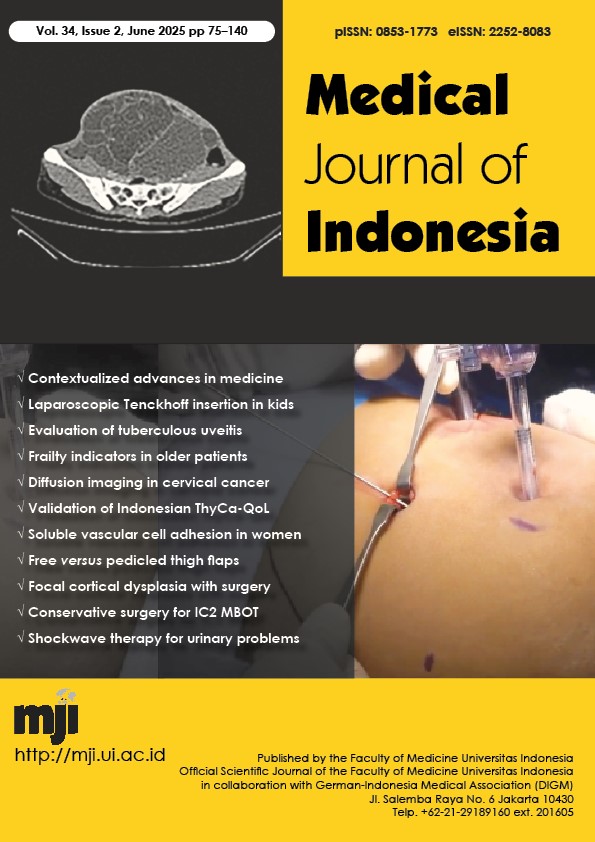Subcutaneous emphysema: an indirect sign of anastomotic leak in cecal volvulus
DOI:
https://doi.org/10.13181/mji.cr.247507Keywords:
anastomotic leak, cerebral palsy, subcutaneous emphysema, volvulusAbstract
Cecal volvulus (CV) is a rare cause of intestinal obstruction. A 22-year-old man with cerebral palsy presented with intestinal obstruction symptoms for 2 days. Abdominal computed tomography (CT) revealed a severely dilated cecum, confirmed as CV, during exploratory laparotomy. A right hemicolectomy with primary anastomosis was performed due to an unhealthy cecum. However, his postoperative recovery was stormy as he developed right flank subcutaneous emphysema, but the surgical drain was empty. Follow-up CT showed no extravasation of oral contrast from the lumen, but a relaparotomy noticed a small leak at the posterolateral aspect of the anastomosis, which was reinforced. He recovered well and was discharged 5 days after the relaparotomy. In conclusion, despite being uncommon, subcutaneous emphysema can become an indirect sign of an anastomotic leak even in a negative CT scan.
Downloads
References
Horesh N, Nadler R, Pery R, Gravetz A, Amitai MM, Rosin D, et al. Surgical treatment of cecal volvulus. Clin Surg. 2017;2:1346.
Halabi WJ, Jafari MD, Kang CY, Nguyen VQ, Carmichael JC, Mills S, et al. Colonic volvulus in the United States: trends, outcomes, and predictors of mortality. Ann Surg. 2014;259(2):293−301. https://doi.org/10.1097/SLA.0b013e31828c88ac
Miyao M, Takahashi T, Okusa M, Kusakabe M, Takano R, Masuda Y, et al. Recurrent bowel obstruction caused by cecal volvulus: a case report. J Nippon Med Sch. 2019;86(3):183−6. https://doi.org/10.1272/jnms.JNMS.2019_86-308
Yap P, Hayati F, Sahid NA, Azizan N, Kadir F, Zakaria AD, et al. A lesson to learn an iatrogenic perforation of sigmoid volvulus after endoscopic derotation. Gazi Med J. 2019;30(2):212-4. https://doi.org/10.12996/gmj.2019.54
Tan KN, Yap YL, Low QJ. Management of bilateral extensive subcutaneous emphysema. Borneo J Med Sci. 2022;16(1):43-7. https://doi.org/10.51200/bjms.v16i1.3301
Hayati F, Mohd Azman ZA, Nasuruddin DN, Mazlan L, Zakaria AD, Sagap I. Serum procalcitonin predicts anastomotic leaks in colorectal surgery. Asian Pac J Cancer Prev. 2017;18(7):1821−5.
Jones A, Pisano U, Elsobky S, Watson AJ. Grossly delayed massive subcutaneous emphysema following laparoscopic left hemicolectomy: a case report. Int J Surg Case Rep. 2015;6C:277−9. https://doi.org/10.1016/j.ijscr.2014.10.007
Dunckley M, Smedley F, Andrews B. Acute subcutaneous emphysema: a rare clinical presentation of large bowel perforation. JRSM Open. 2023;14(2):20542704231153529. https://doi.org/10.1177/20542704231153529
Published
How to Cite
Issue
Section
License
Copyright (c) 2025 Vee Chuan Hoe, Shu Ning Kong, Peh Voon Yeow Gilbert, Muhammad Amirrul Nizam Razi, Rohamini Sibin, Firdaus Hayati

This work is licensed under a Creative Commons Attribution-NonCommercial 4.0 International License.
Authors who publish with Medical Journal of Indonesia agree to the following terms:
- Authors retain copyright and grant Medical Journal of Indonesia right of first publication with the work simultaneously licensed under a Creative Commons Attribution-NonCommercial License that allows others to remix, adapt, build upon the work non-commercially with an acknowledgment of the work’s authorship and initial publication in Medical Journal of Indonesia.
- Authors are permitted to copy and redistribute the journal's published version of the work non-commercially (e.g., post it to an institutional repository or publish it in a book), with an acknowledgment of its initial publication in Medical Journal of Indonesia.





































